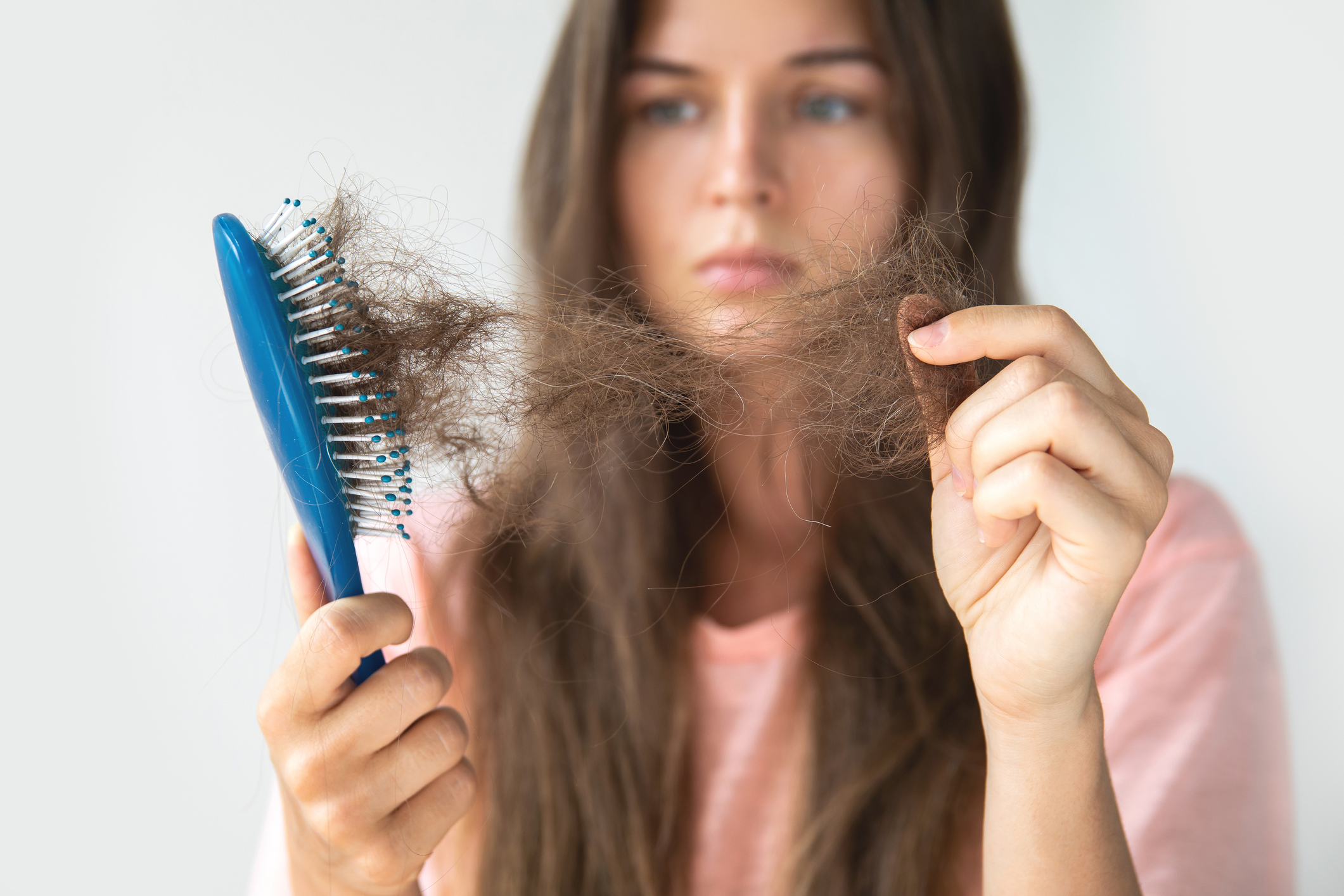
Article content
- Hair loss in pregnancy, after childbirth and during breastfeeding
- Article content
- Facts
- What is Telogen Effluvium?
- Hair growth phase or hair cycle
- Hair fall and thinning in pregnancy
- Hair fall and thinning after childbirth
- Hair fall when breastfeeding
- What did I do with my hair during pregnancy, after giving birth and while breastfeeding?
- Therapeutic support for hair growth during pregnancy and after childbirth
- Make an appointment
- Similar posts
Facts
- Excessive hair loss after childbirth and during breastfeeding is normal and common
- Excessive hair loss during pregnancy is uncommon
- Usually a return to normal occurs within 12 months after delivery
- You can support your recovery with a good diet and lifestyle
- There are medical remedies for restoring hair growth with good results
- If hair loss persists for a longer time, it is necessary to see a doctor
The hair cycle goes through different phases during life. Certain events such as pregnancy, childbirth and breastfeeding can affect this cycle and lead to temporary changes. Including increased hair loss. The most common manifestation during this period is Telogen Effluvium. It is important to understand why this is happening and how to cope with it.
What is Telogen Effluvium?
Telogen Effluvium is a common type of hair loss that occurs after the body experiences severe stress or a change in the body. Symptoms include extreme hair loss and thinningusually around the top of the head. In most cases, hair grows back in three to six months without treatment.
Pregnancy and childbirth are associated with major changes in the body, hair loss in this period is most often a manifestation of Telogen Effluvium.
Hair growth phase or hair cycle
Why is it important to know about the stages of hair growth? Because the most common cause of hair loss after childbirth is just a change in the hair cycle.
Anagen phase – growth phase
It usually lasts from 2 to 6 years. Usually around 85% of the hair is in the growth phase. In this phase, the hair grows at a rate of approximately 1 cm per month.
Catagen phase – stopping growth
It lasts approximately 2-3 weeks. At this stage, the hair ceases to be nourished. The hair no longer grows and the hair bulb is inactive.
Telogen phase – phase of shedding
It lasts between 2-3 months and less than 10% of hair is at this stage. The hair falls out and is replaced by new hair in the anagen phase. And the cycle of hair growth repeats again.
Hair fall and thinning in pregnancy
During pregnancy, a woman’s body is exposed to many hormonal changes. Estrogen and progesterone are two hormones that rise in the body during pregnancy. This increased level of hormones can cause more hair to remain in the growth phase (anagen), which therefore becomes longer. This means that you lose less hair. Hair looks richer, fuller, healthier. This is why many women experience thicker, shinier hair during pregnancy.
Pregnancy should therefore improve the quality and number of hair. But if you observe the opposite effect, it is good not to underestimate it. Excessive hair loss in pregnancy can indicate hormonal problems or a deficiency of certain important vitamins and minerals. And of course, these are not only important for your hair, but also for the proper growth and development of the fetus. Alternatively, it may be the first manifestations of some type of alopecia.
Hair fall and thinning after childbirth
If you have noticed increased hair loss a few months after giving birth, you are not alone. This phenomenon is called postpartum telogen effluvium and is perfectly normal. After hormone levels return to normal after childbirth, many hairs that were in the growth phase during pregnancy go into the catagen phase and then fall out (telogen phase).
There is, of course, a time delay. It is necessary to account for several weeks during which the hair stops growing, followed by 2 to 3 months before the hair falls out and is replaced by a new one.
The onset of hair loss can be rapid and dramatic, with a significant amount of hair falling out. It is important to remember that this is temporary. Most women notice a return to normal hair condition and quality within six to twelve months after giving birth. If not, it may be chronic telogen effluvium or androgenetic alopecia.
Hair fall when breastfeeding
Some women may notice continued hair loss during breastfeeding. This is usually due to ongoing hormonal changes, which may be amplified by the stress and lack of sleep associated with caring for a newborn. Again, this is normal to some extent. However, if the hair fall persists for a long time or the hair loss is increasing, it is a good idea to contact a dermatologist who specializes in hair diseases.
What did I do with my hair during pregnancy, after giving birth and while breastfeeding?
What can you do about hair loss in pregnancy or after childbirth?
Most of the time, however, patience is the most important thing. While hair loss can be frustrating, in most cases it is temporary and your hair will return to normal once your body recovers from childbirth.
But if your hair loss persists for a long time, see a doctor. This can prevent more serious complications and speed up the recovery of your hair.
Ageless tips that work unless there is a serious health problem include a balanced diet. This should include good quality protein, omega-3 and 6 fatty acids (fish, vegetable oils, nuts, seeds) iron and vitamins B and C. Avoid alcohol and smoking (which you should do anyway, at least during pregnancy and breastfeeding), drink plenty of water, avoid stress and sleep well (haha :-) ) Choose any supplements carefully and always consult your doctor about their suitability.
Therapeutic support for hair growth during pregnancy and after childbirth
- Mesotherapy
Mesotherapy is a non-surgical medical procedure that can help stimulate hair growth. It involves a series of small injections that introduce special substances into the scalp. These substances may contain vitamins, minerals, amino acids and other nutrients that are beneficial for healthy hair growth.
- Plasmatherapy
Plasmatherapy, also known as PRP (Platelet-Rich Plasma), is another option to promote hair growth. This therapy involves taking a small amount of blood from the patient, separating the platelets and plasma, and then injecting this concentrated solution back into the scalp. Platelets and other growth factors contained in the plasma then stimulate hair growth.
- Microneedling
Microneedling is another method that can promote hair growth. This method involves the use of a small tool with many fine needles that is passed over the scalp to create small micro-traumas. These micro-injuries can stimulate the body’s natural ability to heal itself, leading to increased production of collagen and other growth factors that can promote hair growth.
- Medications
The most commonly used drug to promote hair growth is minoxidil which must not be used during pregnancy. If you are using minoxidil and find out you are pregnant, stop taking it. During pregnancy and after childbirth, it is advisable to focus on a proper lifestyle, getting enough vitamins and minerals. After breastfeeding, it is possible to start with classical medical treatment.





